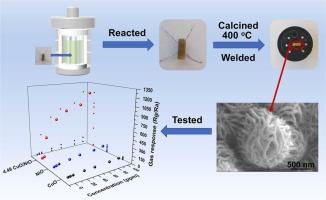基于层状CuO/NiO微球原位生长的低温H2S传感器及其传感机理
IF 3.7
1区 化学
Q1 CHEMISTRY, ANALYTICAL
引用次数: 0
摘要
纳米材料的原位生长与明确的层次结构相结合,可以赋予气体传感器优越的传感能力。本文采用简单的一步离子液体辅助溶剂热法在陶瓷管上原位生长CuO/NiO微球,然后进行煅烧。所得CuO/NiO复合材料具有交错纳米片支撑的微球、多晶性质和介孔结构。与原始NiO沉积薄膜传感器相比,4.49 at% CuO修饰的NiO微球传感器在92°C时具有更强的H2S传感性能。对100ppm H2S气体的响应(1157.4)是原始NiO(154.2)的7.5倍,检测限进一步从0.1 ppb降低到0.05 ppb。从p-p异质结、层次结构以及CuO修饰NiO微球的协同效应等方面阐述了H2S的主导传感机理。因此,基于分层CuO/NiO微球的原位沉积传感器对ppm和ppb水平的H2S气体具有高选择性、快速响应和恢复速度,以及良好的稳定性,适用于复杂环境下H2S气体的实时监测。本文章由计算机程序翻译,如有差异,请以英文原文为准。

Low-temperature H2S sensor based on in situ growth of hierarchical CuO/NiO microspheres and the sensing mechanism
In situ growth of nanomaterials combined with well-defined hierarchical structure may endow a gas sensor with superior sensing capability. Herein, the hierarchical CuO/NiO microspheres were in situ grown on ceramic tubes via a facile one-step ionic liquid (IL)-assisted solvothermal process with subsequent calcination. The resultant CuO/NiO composites demonstrated the interlaced nanosheets-supported microspheres, polycrystalline nature and mesoporous structure. Compared with pristine NiO deposited film sensors, the 4.49 at% CuO modified NiO microspheres sensors exhibited enhanced H2S sensing performances at 92 °C. The response (1157.4) to 100 ppm H2S gas was 7.5 times as high as that of pristine NiO (154.2), and the detection limit was further decreased from 0.1 ppb of the pristine NiO sensor to 0.05 ppb. The dominant H2S sensing mechanism was elaborated from the view of p-p heterojunction, hierarchical architecture as well as the synergistic effect of CuO decorated NiO microspheres. Thus, the in situ deposited sensors based on hierarchical CuO/NiO microspheres presented high selectivity, rapid response and recovery speed, and good stability towards ppm and ppb levels of H2S gas, making it suitable for real-time monitoring of H2S gas in complex environments.
求助全文
通过发布文献求助,成功后即可免费获取论文全文。
去求助
来源期刊

Sensors and Actuators B: Chemical
工程技术-电化学
CiteScore
14.60
自引率
11.90%
发文量
1776
审稿时长
3.2 months
期刊介绍:
Sensors & Actuators, B: Chemical is an international journal focused on the research and development of chemical transducers. It covers chemical sensors and biosensors, chemical actuators, and analytical microsystems. The journal is interdisciplinary, aiming to publish original works showcasing substantial advancements beyond the current state of the art in these fields, with practical applicability to solving meaningful analytical problems. Review articles are accepted by invitation from an Editor of the journal.
 求助内容:
求助内容: 应助结果提醒方式:
应助结果提醒方式:


